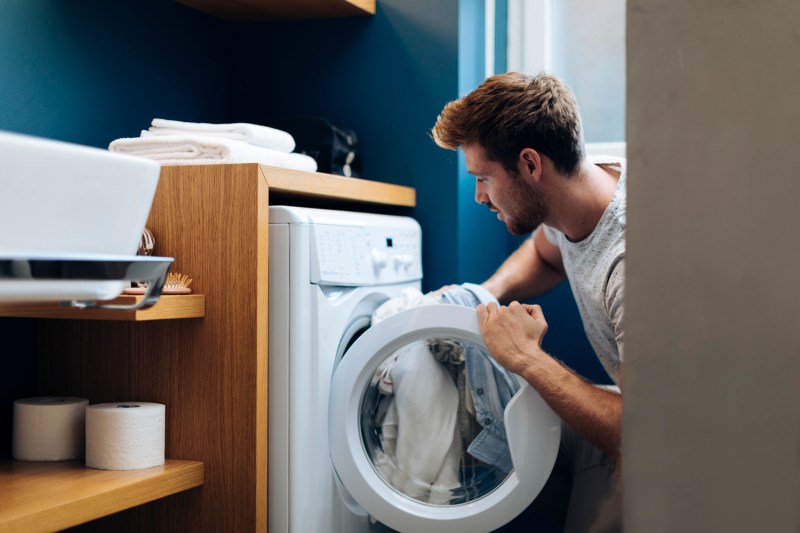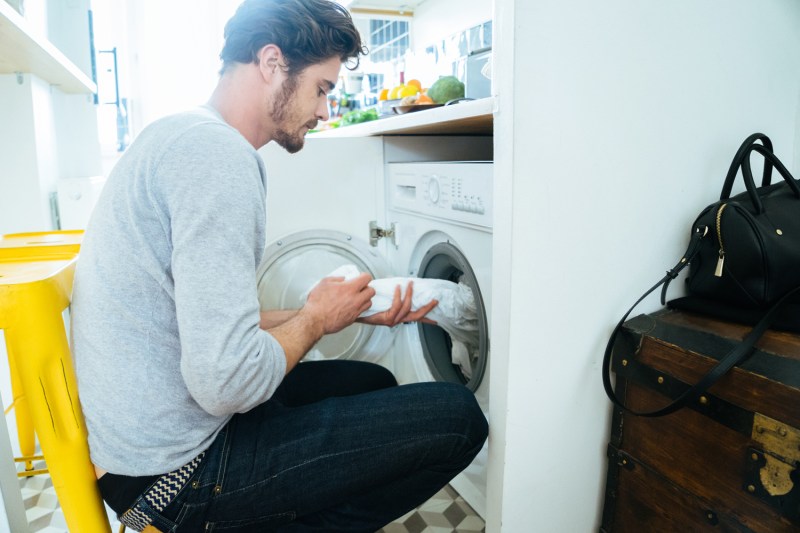
Let’s recall some of your not-so-good childhood memories. Remember the time when Mom threw up her hands in frustration at the mountain of dirty clothes in your room? Or how about the time when you first washed your clothes? Hey, maybe you found it to be mundane and repetitive. Whether you love or hate doing the laundry, this household chore is an important rite in the transition from childhood to adulthood. Sadly, only a few of us are properly guided through this transition.
Doing the laundry is a life skill that helps you become a more independent and reliable adult, especially if you plan to settle down or have your own place. If you’ve frequently crossed your fingers after dropping the lid on a load of clothes, worry no wore. Our laundry master guide includes all the “obvious” answers you never knew, plus some tips on the finer points of keeping your duds fresh.
How to Do Laundry the Right Way
Do I Really Need to Separate Lights and Darks?

As a kid, my mom came up with a system for making sure laundry colors stayed separate — rather than each family member having their own hamper, we had three big baskets in the hallway labeled “Whites,” “Mediums,” and “Darks.” With the system set up for us, it was easy to follow, though I still often vacillated over where a specific item qualified. (Is brown a medium or a dark? Should pale yellow count as a white?)
Going to college changed it all with the addition of one single element to the washer: a coin slot. Never having enough quarters on hand meant that all my clothes went into the same load, and guess what? None of them looked any worse for wear.
The short answer: No, you don’t have to separate lights and darks.
The caveat: If you’re washing a brand-new item, keep it with similar colors, since it has the potential to bleed (especially red). And if you’re trying to brighten your whites with a hot water wash, do those separately to avoid shrinking other items.
How Do I Add Detergent?

This answer depends on two factors: The type of washing machine you’re using and the type of detergent.
Washing machines generally fall into two categories. There are front loaders and top loaders. Most detergents are designed for one type of washer only, and believe it or not, there is a difference. Top-loader detergent produces a lot more suds—using it in a front-loader could lead to a big bubbly mess.
If you’re using a front-loading machine, it probably includes a little drawer where detergent is meant to be inserted — there might even be markings for where to put liquid versus powdered detergent. Some liquid detergents, however, come with a dosing ball that releases the detergent at a specific moment in the wash cycle. Either way, it’s pretty easy. Measure out the detergent according to package directions (which will tell you how much to use depending on the size of your laundry load), drop into the drawer (or dosing ball), and proceed.
If you’re using a top-loading washing machine, measure detergent in the same way and add it to the washing machine before you put the clothes in. Give the machine a few seconds to fill with water before adding clothes, so that the detergent has a chance to dissipate.
When Do I Use Bleach?

The bleach learning curve is quick and steep—it only takes one mistake to teach you how to properly use bleach. What sucks is when that lesson comes at the cost of a wardrobe standby. To prevent pulling out your favorite hoodie only to find a big white splatter on it or finding your softest white tee looking like it’s been through a gunfight, it’s important to make sure you know what you’re working with. That means, first and foremost, looking at the care tags on whatever you’re washing, to see if there are any instructions about using bleach. It’s also a good idea to test a little bit of diluted bleach on the garment—you can apply a tiny dab to the underarm or inside seam, just to make sure nothing happens that you wouldn’t want to see happen to the whole garment.
When you’re bleaching, make sure to use a small amount (the package directions should guide you according to your load size), and add your bleach to the washing water before you put in the clothes. Be advised, however, that repeated bleaching can wear out your clothes and even cause yellowing. For a more sustainable whitening/brightening option, you’re better off adding a scoop of washing soda and a cup or so of white vinegar to your laundry.
When Do I Not Use the Dryer?

More and more clothes dryers are coming with variable settings these days, which is great news for your wardrobe — high heat can really wear out your clothes. However, some types of fabric are best left to air-dry, especially if it’s an item where the fit is everything (like workout clothes or skinny jeans).
In general, anything with elastic or Spandex shouldn’t be put in the dryer, since the heat will break down the stretchiness. Any garments that include silk, wool, suede, or leather should be kept out of the dryer, as well.
Denim is a controversial one — whether to dry or not dry your jeans depends a lot on your personal preferences. If you invest in heritage denim, or care a lot about a perfect fit, you’re better off air-drying your jeans. If, on the other hand, your jeans are more about function than form, go ahead and toss them in the dryer. In addition, it’s best not to mix wildly different types of fabrics in the dryer. Putting your best collared shirts in with the Mexican blanket you take to the park will result in a lengthy lint-brushing session later.
What Settings Should I Use?

As a general rule, cool or cold water settings are the best option for washing. Lower temperatures protect colors from fading or bleeding, and prevent shrinkage (especially along the seams, where shrinking is most likely to happen). Cool water is also better for treating stains, which are more likely to set in warm water. Using cold or cool water also saves energy, which is very environmentally responsible.
However, certain types of clothes are best laundered in certain settings:
- Workout/athletic clothes: Coldwater, air-dry
- Nice collared shirts, chinos, and trousers: Cool water (except for white shirts) dry on low heat hang up while still warm
- Sweaters and other wool items: Coldwater on delicate or hand-wash setting, lay flat to dry
If you are having problems with your washing machine smell, here you can read our guide on how to get rid of that bad smell.
Best Laundry Essentials
Smart Sheep 6-Pack Wool Dryer Balls

Just say no to fishing dryer sheets out of your sleeves and pant legs. Not only do these balls of natural wool reduce static cling, but they also absorb moisture, reducing the energy required to get your clothes dry (another environmentally friendly bonus!). A drop or two of your favorite essential oil adds a nice, subtle fragrance to your clean laundry.
Nellie’s Wow Stick Stain Remover

My grandma’s go-to stain remover was a toothbrush dipped in a petroleum-based potion. It did the job, but it left a funny smell and it sort of freaked me out that I was wearing a gasoline byproduct. Nellie’s WOW! Stick takes the same principle — oil dissolves oil — and makes it easy. Just soak the spot with the stain, rub the stick on it, and scrub it all together underwater. Not only is the WOW Stick safe for even delicate fabrics, but it leaves behind a nice orange/lemongrass scent.
Homz Hanging Sweater Drying Rack

Maximize your laundry room space and keep those cashmere sweaters looking wrinkle-free (and the right size!) with this multi-tiered hanging rack for drying sweaters.
The Laundress Wool and Cashmere Soap

No need to scour your mom’s cupboard for that ancient bottle of Woolite. This cedar-scented soap from The Laundress is the perfect way to get your delicates clean. The pH-neutral formulation removes odor, dirt, and oil while preserving your sweaters’ softness as well as the lanolin coating that is natural to wool.


